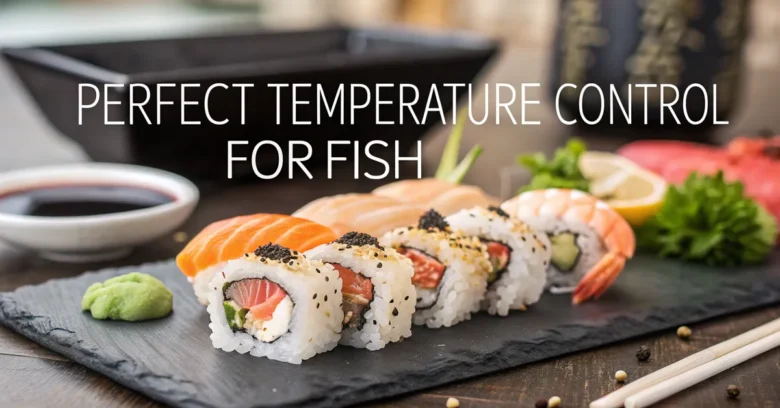The delicate dance of sushi preparation hinges on many factors, but one often overlooked yet critical aspect is fish temperature. Getting it wrong can lead to a host of problems, from compromising the texture and flavor to even posing a health risk. But getting it right? It’s the key to unlocking the full potential of your ingredients.
Think of it this way: imagine a world-class violinist trying to perform with a poorly tuned instrument. The skill is there, the passion is there, but the execution falls flat. Similarly, even the most expertly sourced and prepared fish can be diminished by improper temperature control.
So, how do you, a sushi chef dedicated to mastering your craft, ensure your fish is always at its prime? This article will dive deep into the science and practical techniques behind achieving perfect fish temperature, transforming your sushi from good to exceptional.
The Why of Fish Temperature: More Than Just Freshness
Before diving into the “how,” let’s explore why fish temperature is so crucial. It’s not simply about keeping the fish “fresh,” though that’s certainly part of it. It’s about understanding how fish temperature affects the very structure and safety of your ingredients.
Texture Transformation: From Firm to Mush
Temperature has a profound impact on the texture of fish. Think about the difference between a frozen block of tuna and a perfectly sliced piece of sashimi. The key lies in the muscle fibers and water content.
- Freezing: Freezing fish temperature causes water inside the cells to expand and form ice crystals. These crystals rupture the cell walls, leading to a mushy texture upon thawing. This is why freezing and thawing degrades the quality of sashimi-grade fish. Flash freezing techniques, if used correctly, can minimize ice crystal formation, but it’s still not ideal for all species.
- Warm Temperatures: On the other end of the spectrum, allowing fish to get too warm encourages the growth of bacteria (more on that later). It also starts to break down proteins, resulting in a soft, almost slimy texture.
- Optimal Cold: Maintaining the proper cold fish temperature, typically just above freezing, keeps the muscle fibers firm and intact. This results in that desirable “snap” or “bite” that defines high-quality sushi.
Flavor Dynamics: A Symphony of Taste
Fish temperature also plays a significant role in how we perceive flavor. Cold temperatures actually suppress our taste buds, which is why ice cream tastes less sweet when it’s very cold. However, for sushi, a slightly chilled fish temperature allows subtle flavors to shine.
- Balancing Act: Too cold, and the nuances of the fish are muted. Too warm, and unwanted flavors (often associated with bacterial activity) become more prominent.
- Fatty Fish: Fatty fish like salmon and tuna benefit especially from careful fish temperature control. The fat molecules solidify at lower temperatures, creating a richer, smoother mouthfeel.
- Subtle Notes: With leaner fish like snapper or sea bass, the right fish temperature allows their delicate, almost sweet flavors to emerge.
The Safety Imperative: Preventing Bacterial Growth
Perhaps the most critical reason to maintain proper fish temperature is to prevent the growth of harmful bacteria. Fish, especially raw fish, can harbor bacteria that can cause foodborne illness.
- The Danger Zone: The “danger zone” for bacterial growth is typically between 40°F (4°C) and 140°F (60°C). Within this range, bacteria multiply rapidly, increasing the risk of illness.
- Controlling the Clock: The longer fish remains in the danger zone, the greater the risk. This is why time and fish temperature are inextricably linked.
- Specific Pathogens: Common bacteria associated with raw fish include Vibrio, Salmonella, and Listeria. These can cause a range of symptoms, from mild gastrointestinal upset to more severe complications.
Regulations and Guidelines
Due to the inherent risks of consuming raw fish, strict regulations and guidelines are in place to ensure safety.
- HACCP Plans: Many restaurants and fish suppliers follow Hazard Analysis and Critical Control Point (HACCP) plans, which identify potential hazards and implement controls to minimize risks.
- FDA Guidelines: The FDA provides guidelines for safe handling and storage of seafood, including specific fish temperature recommendations.
- Local Regulations: State and local health departments may have their own specific regulations regarding raw fish preparation. Always consult your local health codes.
The Cold Chain: A Seamless Journey
The ideal scenario is a continuous “cold chain,” where the fish temperature is consistently maintained from the moment the fish is caught until it’s served to the customer. This involves careful monitoring and control at every stage.
From Catch to Auction: The Initial Chill
- Icing at Sea: Reputable fishing vessels immediately ice their catch after harvesting. This rapidly lowers the fish temperature and slows down spoilage.
- Quality Assessment: At the auction, experienced buyers assess the quality of the fish, looking for signs of freshness such as clear eyes, bright red gills, and firm flesh.
- Temperature Logging: Some suppliers use temperature loggers to track the fish temperature throughout the shipping process, providing a verifiable record of proper handling.
Transportation and Storage: Maintaining the Cold
- Refrigerated Trucks: Fish is transported in refrigerated trucks, maintaining a fish temperature close to freezing (around 30-34°F or -1 to 1°C).
- Proper Packaging: Fish is typically packed in ice and insulated containers to prevent temperature fluctuations during transport.
- Receiving Procedures: Upon arrival, the fish should be inspected immediately. Use a calibrated thermometer to verify that the fish temperature is within the safe range. Reject any shipments where the fish temperature is too high.
In the Sushi Kitchen: The Final Frontier
- Dedicated Refrigeration: Designate a specific refrigerator or section of a refrigerator exclusively for raw fish. This prevents cross-contamination and ensures that the fish temperature remains consistent.
- Ice Baths: During preparation, keep fish on a bed of ice to maintain its fish temperature. This is especially important when working with larger cuts of fish that may take longer to prepare.
- Temperature Monitoring: Regularly check the fish temperature with a calibrated thermometer. Insert the thermometer into the thickest part of the fish to get an accurate reading.
Tools of the Trade: Thermometers and Beyond
Accurate temperature measurement is essential for maintaining fish temperature control.
Thermometer Types: Finding the Right Fit
- Digital Thermometers: These are the most common and convenient type of thermometer. Look for a model with a fast response time and a narrow probe for easy insertion into fish.
- Infrared Thermometers: While these don’t provide an internal fish temperature reading, they can be useful for quickly checking the surface temperature of fish or ice.
- Probe Thermometers: These feature a long, thin probe that can be inserted deep into the fish for an accurate reading.
- Calibration is Key: Regardless of the type you choose, it’s essential to calibrate your thermometer regularly to ensure accuracy.
Calibrating Your Thermometer: Ensuring Accuracy
- Ice Water Method: The easiest way to calibrate a thermometer is using the ice water method. Fill a glass with ice and add water. Stir well and let it sit for a few minutes. Insert the thermometer into the ice water, making sure the probe doesn’t touch the sides or bottom of the glass. The thermometer should read 32°F (0°C). If it doesn’t, adjust the calibration screw until it does.
- Boiling Water Method: Another method is to use boiling water. Bring a pot of water to a rolling boil. Insert the thermometer into the boiling water, making sure the probe doesn’t touch the sides or bottom of the pot. The thermometer should read 212°F (100°C) at sea level. Adjust the calibration screw if necessary. Note that the boiling point of water decreases with altitude, so you’ll need to adjust accordingly.
Beyond Thermometers: Creating the Right Environment
- Blast Chillers: These specialized refrigerators rapidly cool food items, helping to maintain quality and prevent bacterial growth.
- Ice Machines: Having a reliable ice machine is essential for keeping fish on ice during preparation and storage.
- Refrigerated Display Cases: These display cases maintain a consistent fish temperature, allowing you to showcase your sushi while keeping it safe.
Species-Specific Considerations: A Nuance Approach
While the general principles of fish temperature control apply to all species, some fish require special attention.
Tuna: The King of Sushi
- Grading Systems: Tuna is often graded based on its fat content and color. Higher grades fetch a premium price.
- Temperature Sensitivity: Tuna is particularly sensitive to fish temperature fluctuations. Improper handling can lead to discoloration and a loss of flavor.
- Aging Techniques: Some sushi chefs “age” tuna to enhance its flavor. This involves storing the fish at a specific fish temperature and humidity for a certain period of time. This requires skill and precise control to avoid spoilage.
Salmon: A Popular Choice
- Farmed vs. Wild: Farmed salmon typically has a higher fat content than wild salmon. This affects its texture and flavor.
- Parasite Concerns: Wild salmon may contain parasites. Freezing is often used to kill parasites, but this can affect the texture.
- Color Enhancement: Some farmed salmon is fed a diet that enhances its color. This doesn’t affect the safety or fish temperature, but it’s something to be aware of.
White Fish: Delicate Flavors
- Lean Profiles: White fish like snapper, sea bass, and halibut are leaner than tuna or salmon. This means they are more prone to drying out if not stored properly.
- Subtle Nuances: These fish have delicate flavors that can be easily overpowered by improper fish temperature or handling.
- Sourcing Matters: The quality of white fish can vary greatly depending on the source. Choose reputable suppliers who prioritize fish temperature control.
Shellfish: Unique Challenges
- Live Storage: Some shellfish, like clams and oysters, are stored live until they are ready to be prepared. This requires specific fish temperature and salinity levels.
- Cooking Requirements: Most shellfish is cooked before being served. Proper cooking temperatures are essential to kill any harmful bacteria.
- Allergy Concerns: Shellfish allergies are common. Take precautions to prevent cross-contamination.
Best Practices: A Sushi Chef’s Guide to Fish Temperature
Here’s a comprehensive checklist of best practices for maintaining perfect fish temperature:
- Source Wisely: Choose reputable suppliers who prioritize fish temperature control and follow HACCP plans.
- Inspect Deliveries: Upon arrival, check the fish temperature with a calibrated thermometer. Reject any shipments where the fish temperature is too high.
- Dedicated Storage: Store raw fish in a dedicated refrigerator or section of a refrigerator.
- Ice Baths: During preparation, keep fish on a bed of ice to maintain its fish temperature.
- Temperature Monitoring: Regularly check the fish temperature with a calibrated thermometer.
- First In, First Out (FIFO): Use the FIFO method to ensure that older fish is used before newer fish.
- Minimize Handling: Handle raw fish as little as possible to prevent contamination and fish temperature fluctuations.
- Proper Sanitation: Wash your hands frequently and sanitize all surfaces and utensils that come into contact with raw fish.
- Employee Training: Train all employees on proper fish temperature control and food safety procedures.
- Document Everything: Keep records of fish temperature logs, supplier information, and employee training.
- Stay Informed: Stay up-to-date on the latest food safety regulations and guidelines.
Common Mistakes: Avoiding Temperature Pitfalls
Even experienced sushi chefs can make mistakes when it comes to fish temperature control. Here are some common pitfalls to avoid:
- Overcrowding the Refrigerator: Overcrowding can restrict airflow and lead to fish temperature fluctuations.
- Leaving Fish Out Too Long: Leaving fish at room temperature for extended periods of time is a recipe for bacterial growth.
- Improper Thawing: Thawing fish at room temperature is dangerous. Thaw it in the refrigerator or under cold running water.
- Relying on Senses Alone: Don’t rely on your senses to determine if fish is safe. Use a thermometer to verify the fish temperature.
- Neglecting Calibration: Failing to calibrate your thermometer regularly can lead to inaccurate fish temperature readings.
- Ignoring the Cold Chain: Failing to maintain a consistent cold chain from supplier to customer can compromise the safety and quality of your sushi.
The Future of Fish Temperature: Innovation and Technology
The future of fish temperature control is likely to involve even more sophisticated technology and data-driven approaches.
- Smart Packaging: Packaging that monitors and records fish temperature throughout the supply chain.
- Real-Time Monitoring: Sensors that continuously track fish temperature in refrigerators and display cases.
- AI-Powered Analysis: Algorithms that predict shelf life and identify potential food safety risks based on fish temperature data.
- Sustainable Solutions: Environmentally friendly refrigeration technologies that reduce energy consumption and minimize the impact on the planet.
Is Perfect Fish Temperature Worth The Effort?
Achieving and maintaining the perfect fish temperature is an ongoing process that requires dedication, attention to detail, and a commitment to food safety. It’s not always easy, and it may require an investment in equipment and training. However, the rewards are well worth the effort.
By mastering fish temperature control, you can elevate your sushi to new heights, delivering a culinary experience that is not only delicious but also safe and enjoyable. So, embrace the science, hone your techniques, and embark on the journey to sushi perfection. Your customers will thank you for it.



